Management and Organisation in a Global Environment Report: Analysis
VerifiedAdded on 2023/06/08
|9
|1699
|50
Report
AI Summary
This report examines two key activities related to management and organization in a global environment. The first activity focuses on Ford and Taylorism, addressing questions about the acceptance of Taylorism in modern Australia, America, and Europe, as well as its application in call center script design. The second activity analyzes Thomas Friedman's views on globalization, including the three eras of globalization and the concept of a 'flat world.' The report discusses the drawbacks and risks associated with Friedman's 'flat world' theory, explores the agreement with Friedman’s iron rule, and investigates the uniformity of globalization across the globe. The conclusion summarizes the key findings, highlighting the relevance of Taylorism in certain contexts and addressing the challenges posed by globalization.
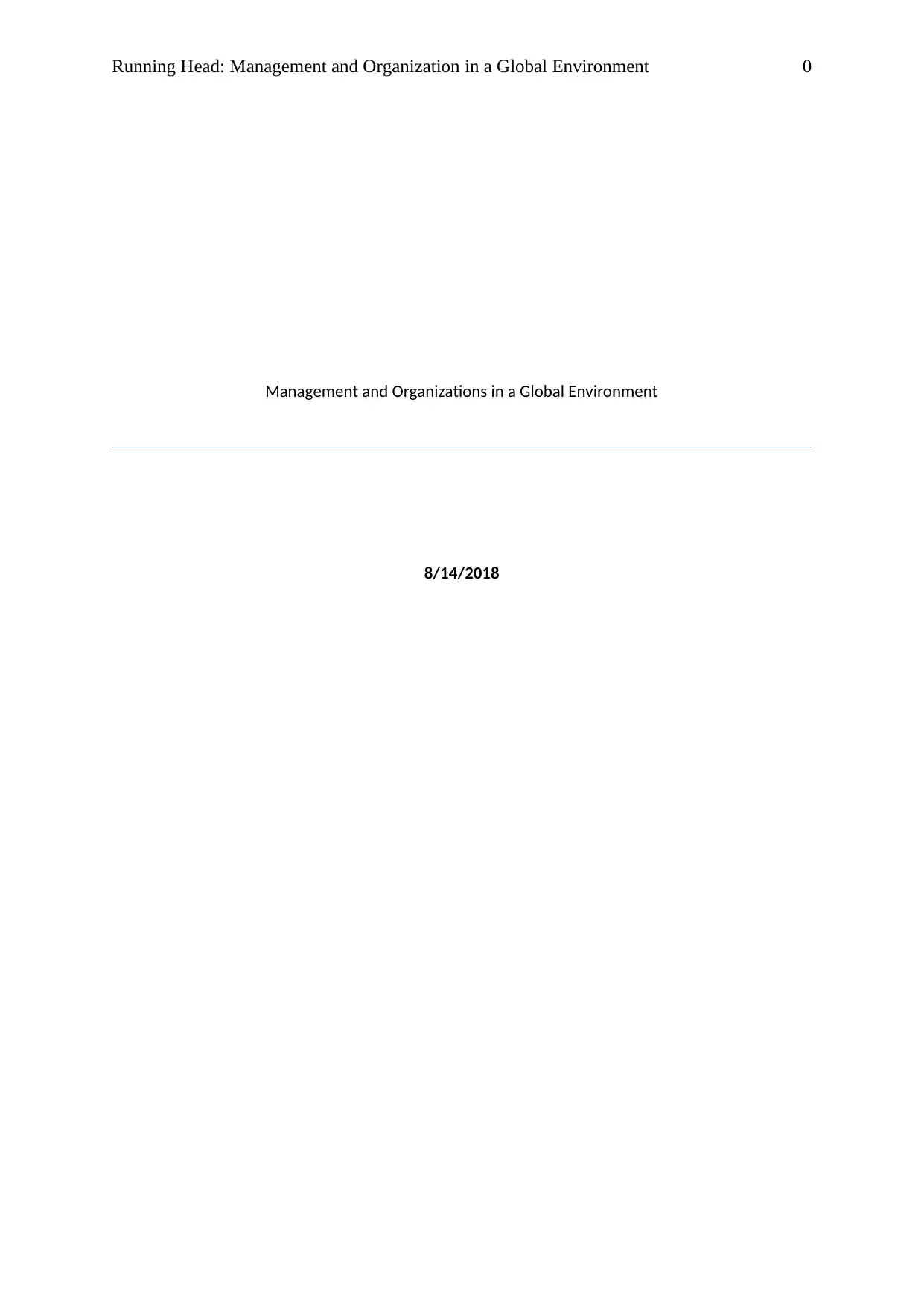
Running Head: Management and Organization in a Global Environment 0
Management and Organizations in a Global Environment
8/14/2018
Management and Organizations in a Global Environment
8/14/2018
Paraphrase This Document
Need a fresh take? Get an instant paraphrase of this document with our AI Paraphraser
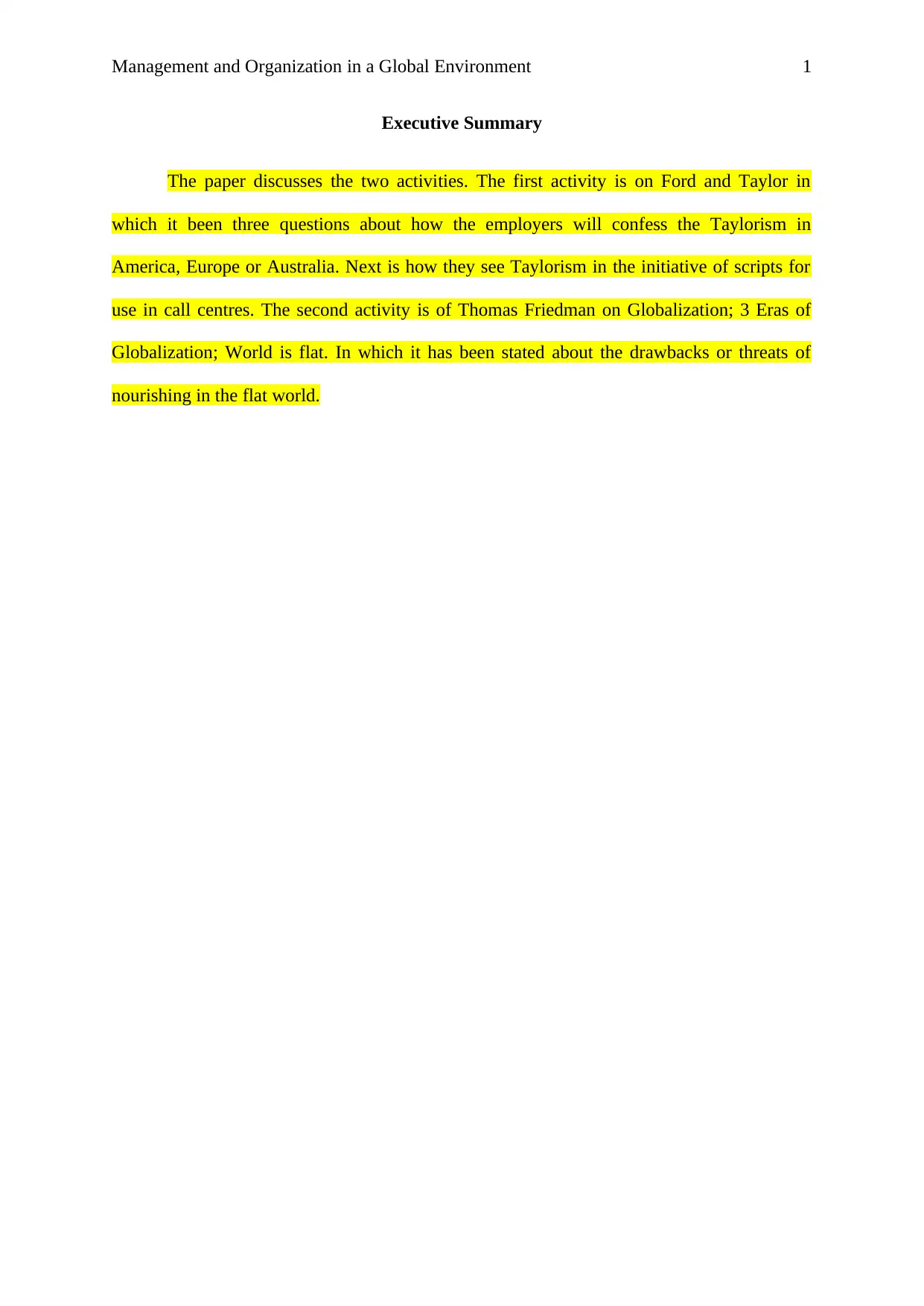
Management and Organization in a Global Environment 1
Executive Summary
The paper discusses the two activities. The first activity is on Ford and Taylor in
which it been three questions about how the employers will confess the Taylorism in
America, Europe or Australia. Next is how they see Taylorism in the initiative of scripts for
use in call centres. The second activity is of Thomas Friedman on Globalization; 3 Eras of
Globalization; World is flat. In which it has been stated about the drawbacks or threats of
nourishing in the flat world.
Executive Summary
The paper discusses the two activities. The first activity is on Ford and Taylor in
which it been three questions about how the employers will confess the Taylorism in
America, Europe or Australia. Next is how they see Taylorism in the initiative of scripts for
use in call centres. The second activity is of Thomas Friedman on Globalization; 3 Eras of
Globalization; World is flat. In which it has been stated about the drawbacks or threats of
nourishing in the flat world.
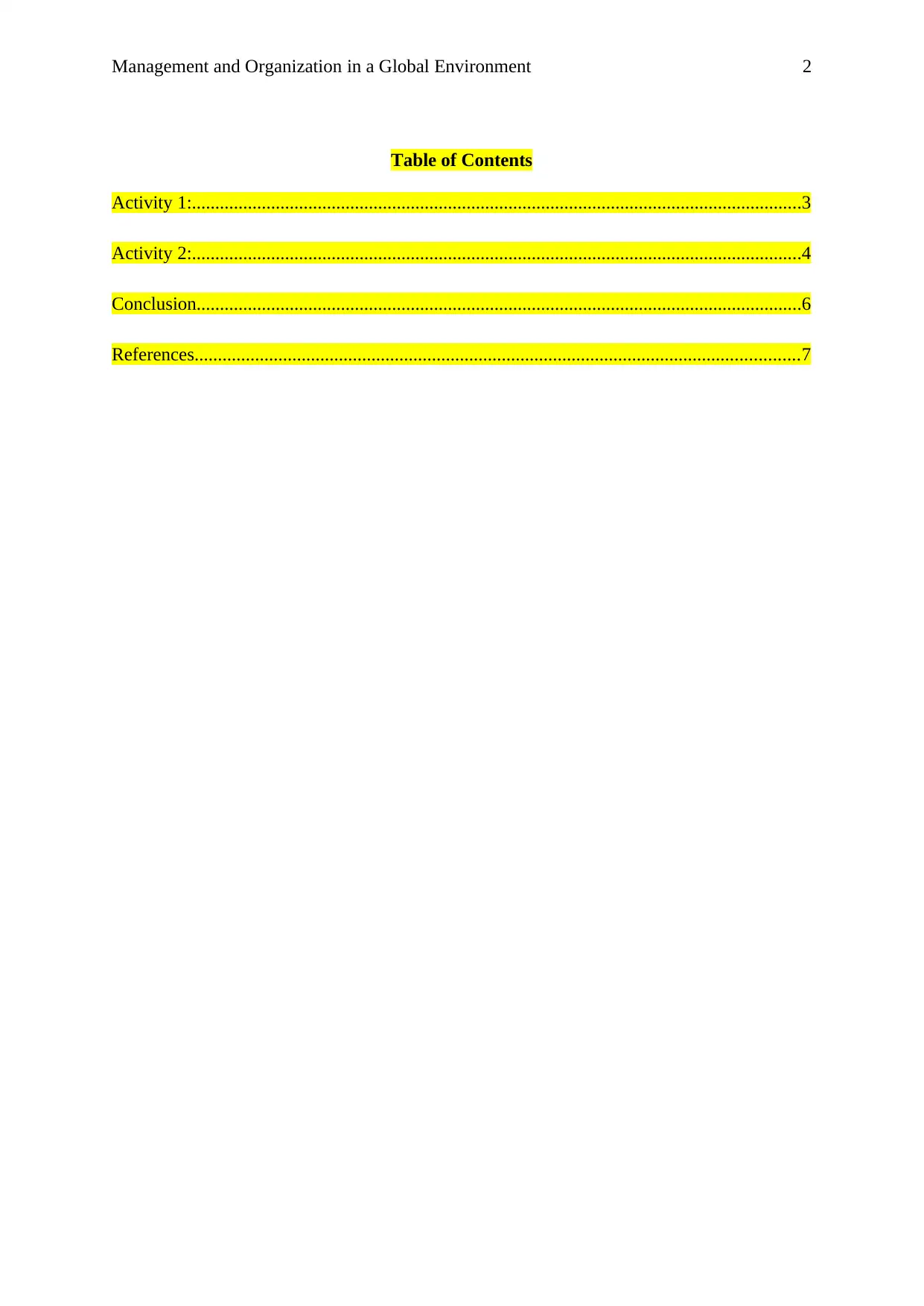
Management and Organization in a Global Environment 2
Table of Contents
Activity 1:...................................................................................................................................3
Activity 2:...................................................................................................................................4
Conclusion..................................................................................................................................6
References..................................................................................................................................7
Table of Contents
Activity 1:...................................................................................................................................3
Activity 2:...................................................................................................................................4
Conclusion..................................................................................................................................6
References..................................................................................................................................7
⊘ This is a preview!⊘
Do you want full access?
Subscribe today to unlock all pages.

Trusted by 1+ million students worldwide
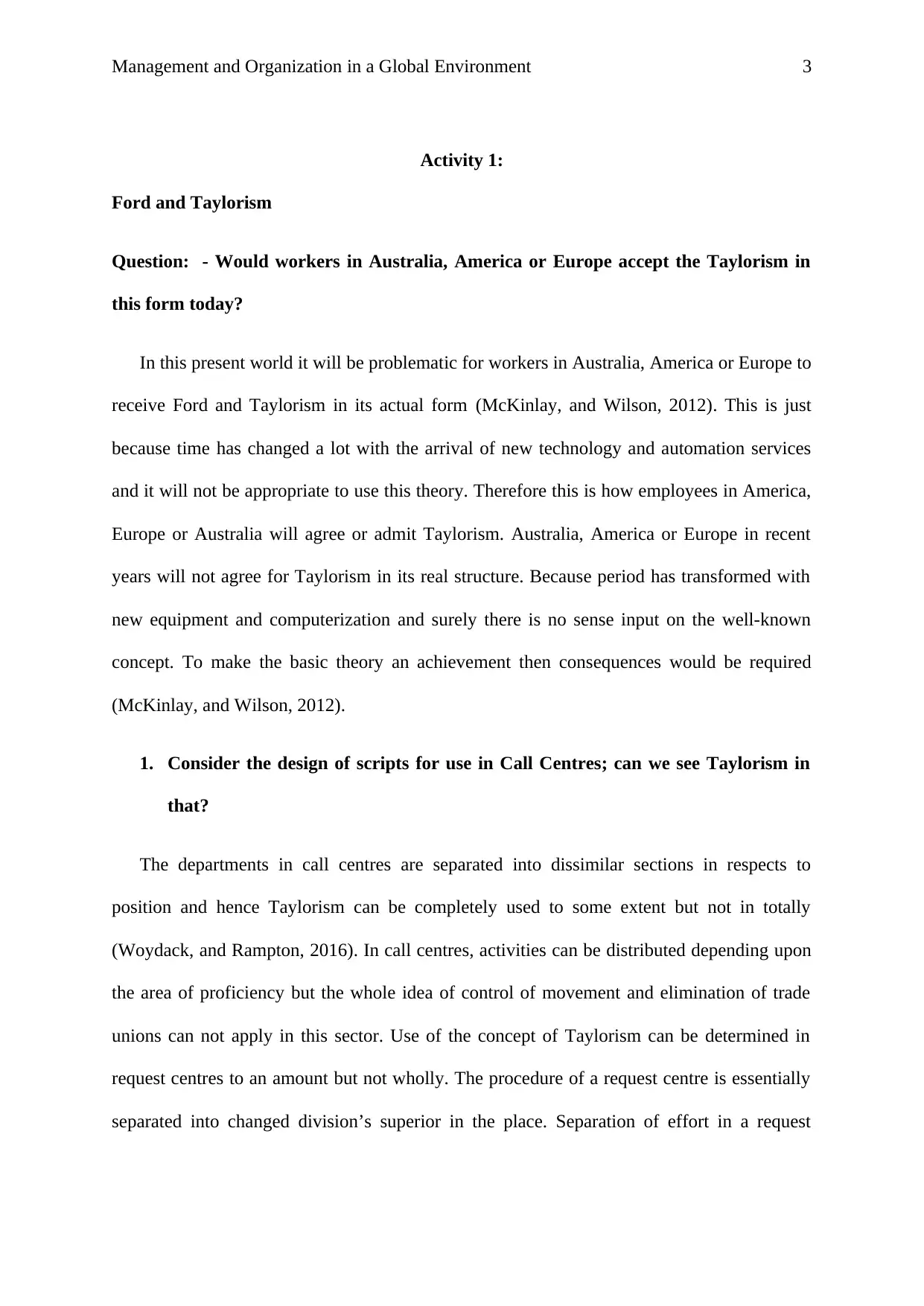
Management and Organization in a Global Environment 3
Activity 1:
Ford and Taylorism
Question: - Would workers in Australia, America or Europe accept the Taylorism in
this form today?
In this present world it will be problematic for workers in Australia, America or Europe to
receive Ford and Taylorism in its actual form (McKinlay, and Wilson, 2012). This is just
because time has changed a lot with the arrival of new technology and automation services
and it will not be appropriate to use this theory. Therefore this is how employees in America,
Europe or Australia will agree or admit Taylorism. Australia, America or Europe in recent
years will not agree for Taylorism in its real structure. Because period has transformed with
new equipment and computerization and surely there is no sense input on the well-known
concept. To make the basic theory an achievement then consequences would be required
(McKinlay, and Wilson, 2012).
1. Consider the design of scripts for use in Call Centres; can we see Taylorism in
that?
The departments in call centres are separated into dissimilar sections in respects to
position and hence Taylorism can be completely used to some extent but not in totally
(Woydack, and Rampton, 2016). In call centres, activities can be distributed depending upon
the area of proficiency but the whole idea of control of movement and elimination of trade
unions can not apply in this sector. Use of the concept of Taylorism can be determined in
request centres to an amount but not wholly. The procedure of a request centre is essentially
separated into changed division’s superior in the place. Separation of effort in a request
Activity 1:
Ford and Taylorism
Question: - Would workers in Australia, America or Europe accept the Taylorism in
this form today?
In this present world it will be problematic for workers in Australia, America or Europe to
receive Ford and Taylorism in its actual form (McKinlay, and Wilson, 2012). This is just
because time has changed a lot with the arrival of new technology and automation services
and it will not be appropriate to use this theory. Therefore this is how employees in America,
Europe or Australia will agree or admit Taylorism. Australia, America or Europe in recent
years will not agree for Taylorism in its real structure. Because period has transformed with
new equipment and computerization and surely there is no sense input on the well-known
concept. To make the basic theory an achievement then consequences would be required
(McKinlay, and Wilson, 2012).
1. Consider the design of scripts for use in Call Centres; can we see Taylorism in
that?
The departments in call centres are separated into dissimilar sections in respects to
position and hence Taylorism can be completely used to some extent but not in totally
(Woydack, and Rampton, 2016). In call centres, activities can be distributed depending upon
the area of proficiency but the whole idea of control of movement and elimination of trade
unions can not apply in this sector. Use of the concept of Taylorism can be determined in
request centres to an amount but not wholly. The procedure of a request centre is essentially
separated into changed division’s superior in the place. Separation of effort in a request
Paraphrase This Document
Need a fresh take? Get an instant paraphrase of this document with our AI Paraphraser
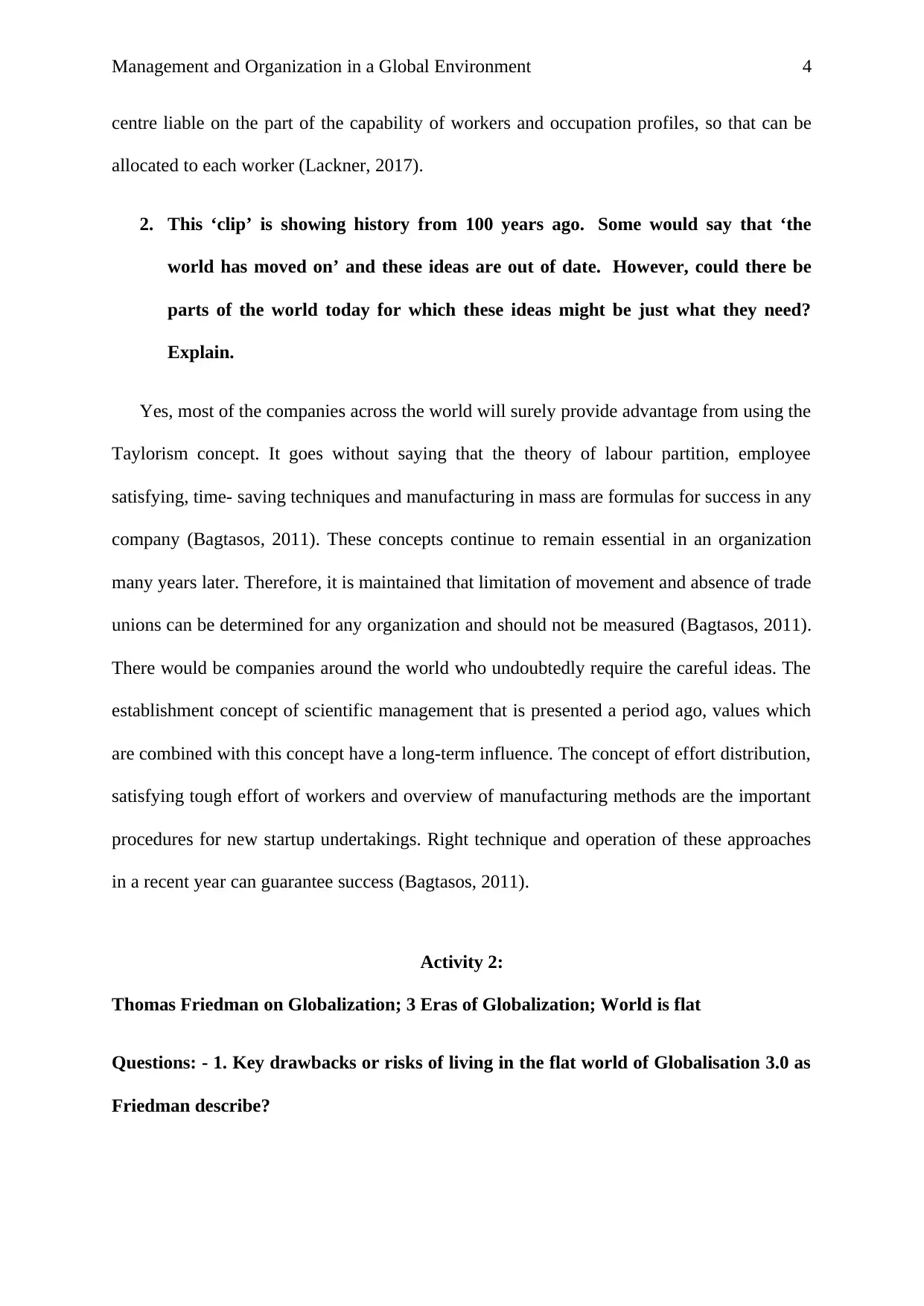
Management and Organization in a Global Environment 4
centre liable on the part of the capability of workers and occupation profiles, so that can be
allocated to each worker (Lackner, 2017).
2. This ‘clip’ is showing history from 100 years ago. Some would say that ‘the
world has moved on’ and these ideas are out of date. However, could there be
parts of the world today for which these ideas might be just what they need?
Explain.
Yes, most of the companies across the world will surely provide advantage from using the
Taylorism concept. It goes without saying that the theory of labour partition, employee
satisfying, time- saving techniques and manufacturing in mass are formulas for success in any
company (Bagtasos, 2011). These concepts continue to remain essential in an organization
many years later. Therefore, it is maintained that limitation of movement and absence of trade
unions can be determined for any organization and should not be measured (Bagtasos, 2011).
There would be companies around the world who undoubtedly require the careful ideas. The
establishment concept of scientific management that is presented a period ago, values which
are combined with this concept have a long-term influence. The concept of effort distribution,
satisfying tough effort of workers and overview of manufacturing methods are the important
procedures for new startup undertakings. Right technique and operation of these approaches
in a recent year can guarantee success (Bagtasos, 2011).
Activity 2:
Thomas Friedman on Globalization; 3 Eras of Globalization; World is flat
Questions: - 1. Key drawbacks or risks of living in the flat world of Globalisation 3.0 as
Friedman describe?
centre liable on the part of the capability of workers and occupation profiles, so that can be
allocated to each worker (Lackner, 2017).
2. This ‘clip’ is showing history from 100 years ago. Some would say that ‘the
world has moved on’ and these ideas are out of date. However, could there be
parts of the world today for which these ideas might be just what they need?
Explain.
Yes, most of the companies across the world will surely provide advantage from using the
Taylorism concept. It goes without saying that the theory of labour partition, employee
satisfying, time- saving techniques and manufacturing in mass are formulas for success in any
company (Bagtasos, 2011). These concepts continue to remain essential in an organization
many years later. Therefore, it is maintained that limitation of movement and absence of trade
unions can be determined for any organization and should not be measured (Bagtasos, 2011).
There would be companies around the world who undoubtedly require the careful ideas. The
establishment concept of scientific management that is presented a period ago, values which
are combined with this concept have a long-term influence. The concept of effort distribution,
satisfying tough effort of workers and overview of manufacturing methods are the important
procedures for new startup undertakings. Right technique and operation of these approaches
in a recent year can guarantee success (Bagtasos, 2011).
Activity 2:
Thomas Friedman on Globalization; 3 Eras of Globalization; World is flat
Questions: - 1. Key drawbacks or risks of living in the flat world of Globalisation 3.0 as
Friedman describe?
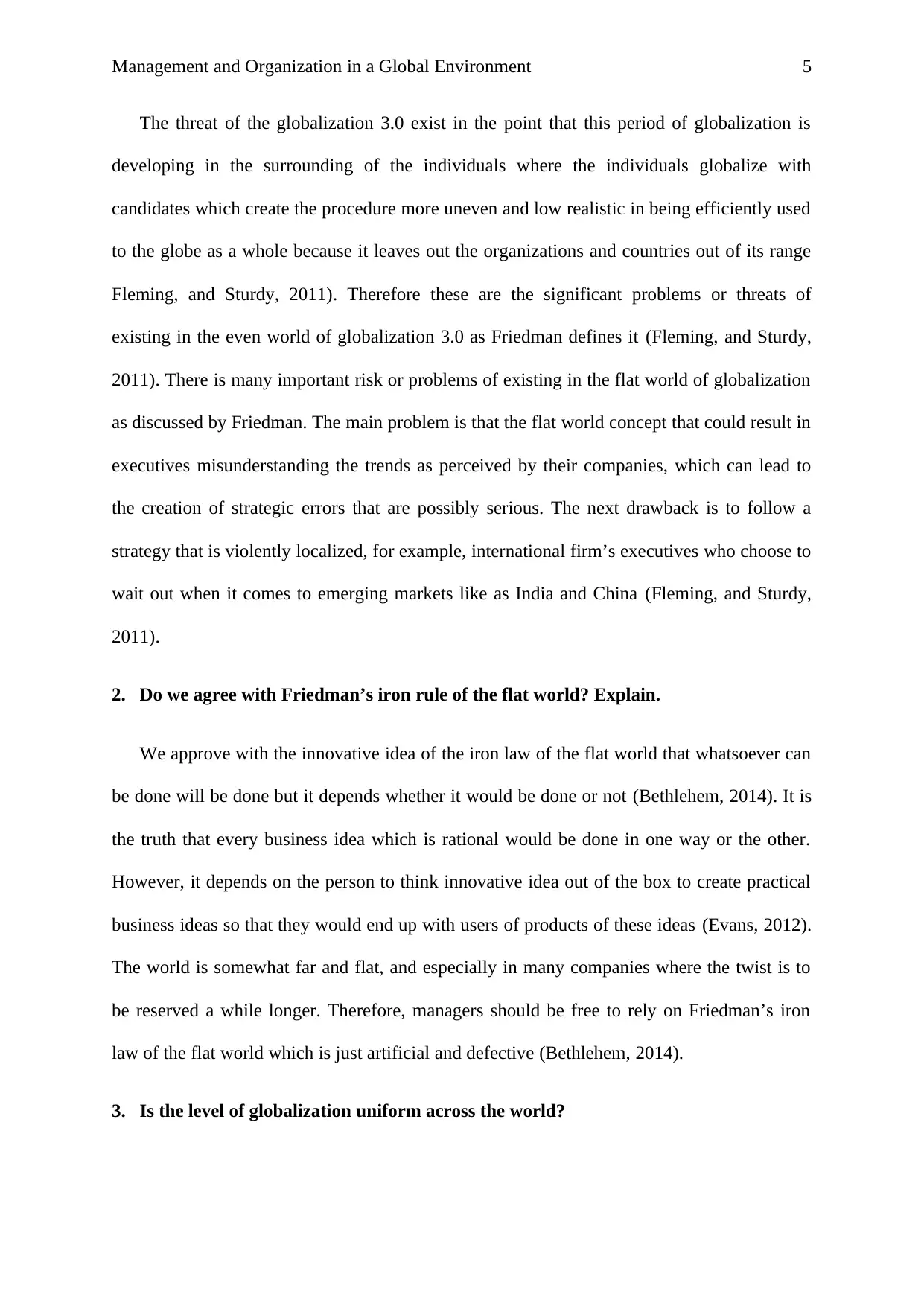
Management and Organization in a Global Environment 5
The threat of the globalization 3.0 exist in the point that this period of globalization is
developing in the surrounding of the individuals where the individuals globalize with
candidates which create the procedure more uneven and low realistic in being efficiently used
to the globe as a whole because it leaves out the organizations and countries out of its range
Fleming, and Sturdy, 2011). Therefore these are the significant problems or threats of
existing in the even world of globalization 3.0 as Friedman defines it (Fleming, and Sturdy,
2011). There is many important risk or problems of existing in the flat world of globalization
as discussed by Friedman. The main problem is that the flat world concept that could result in
executives misunderstanding the trends as perceived by their companies, which can lead to
the creation of strategic errors that are possibly serious. The next drawback is to follow a
strategy that is violently localized, for example, international firm’s executives who choose to
wait out when it comes to emerging markets like as India and China (Fleming, and Sturdy,
2011).
2. Do we agree with Friedman’s iron rule of the flat world? Explain.
We approve with the innovative idea of the iron law of the flat world that whatsoever can
be done will be done but it depends whether it would be done or not (Bethlehem, 2014). It is
the truth that every business idea which is rational would be done in one way or the other.
However, it depends on the person to think innovative idea out of the box to create practical
business ideas so that they would end up with users of products of these ideas (Evans, 2012).
The world is somewhat far and flat, and especially in many companies where the twist is to
be reserved a while longer. Therefore, managers should be free to rely on Friedman’s iron
law of the flat world which is just artificial and defective (Bethlehem, 2014).
3. Is the level of globalization uniform across the world?
The threat of the globalization 3.0 exist in the point that this period of globalization is
developing in the surrounding of the individuals where the individuals globalize with
candidates which create the procedure more uneven and low realistic in being efficiently used
to the globe as a whole because it leaves out the organizations and countries out of its range
Fleming, and Sturdy, 2011). Therefore these are the significant problems or threats of
existing in the even world of globalization 3.0 as Friedman defines it (Fleming, and Sturdy,
2011). There is many important risk or problems of existing in the flat world of globalization
as discussed by Friedman. The main problem is that the flat world concept that could result in
executives misunderstanding the trends as perceived by their companies, which can lead to
the creation of strategic errors that are possibly serious. The next drawback is to follow a
strategy that is violently localized, for example, international firm’s executives who choose to
wait out when it comes to emerging markets like as India and China (Fleming, and Sturdy,
2011).
2. Do we agree with Friedman’s iron rule of the flat world? Explain.
We approve with the innovative idea of the iron law of the flat world that whatsoever can
be done will be done but it depends whether it would be done or not (Bethlehem, 2014). It is
the truth that every business idea which is rational would be done in one way or the other.
However, it depends on the person to think innovative idea out of the box to create practical
business ideas so that they would end up with users of products of these ideas (Evans, 2012).
The world is somewhat far and flat, and especially in many companies where the twist is to
be reserved a while longer. Therefore, managers should be free to rely on Friedman’s iron
law of the flat world which is just artificial and defective (Bethlehem, 2014).
3. Is the level of globalization uniform across the world?
⊘ This is a preview!⊘
Do you want full access?
Subscribe today to unlock all pages.

Trusted by 1+ million students worldwide
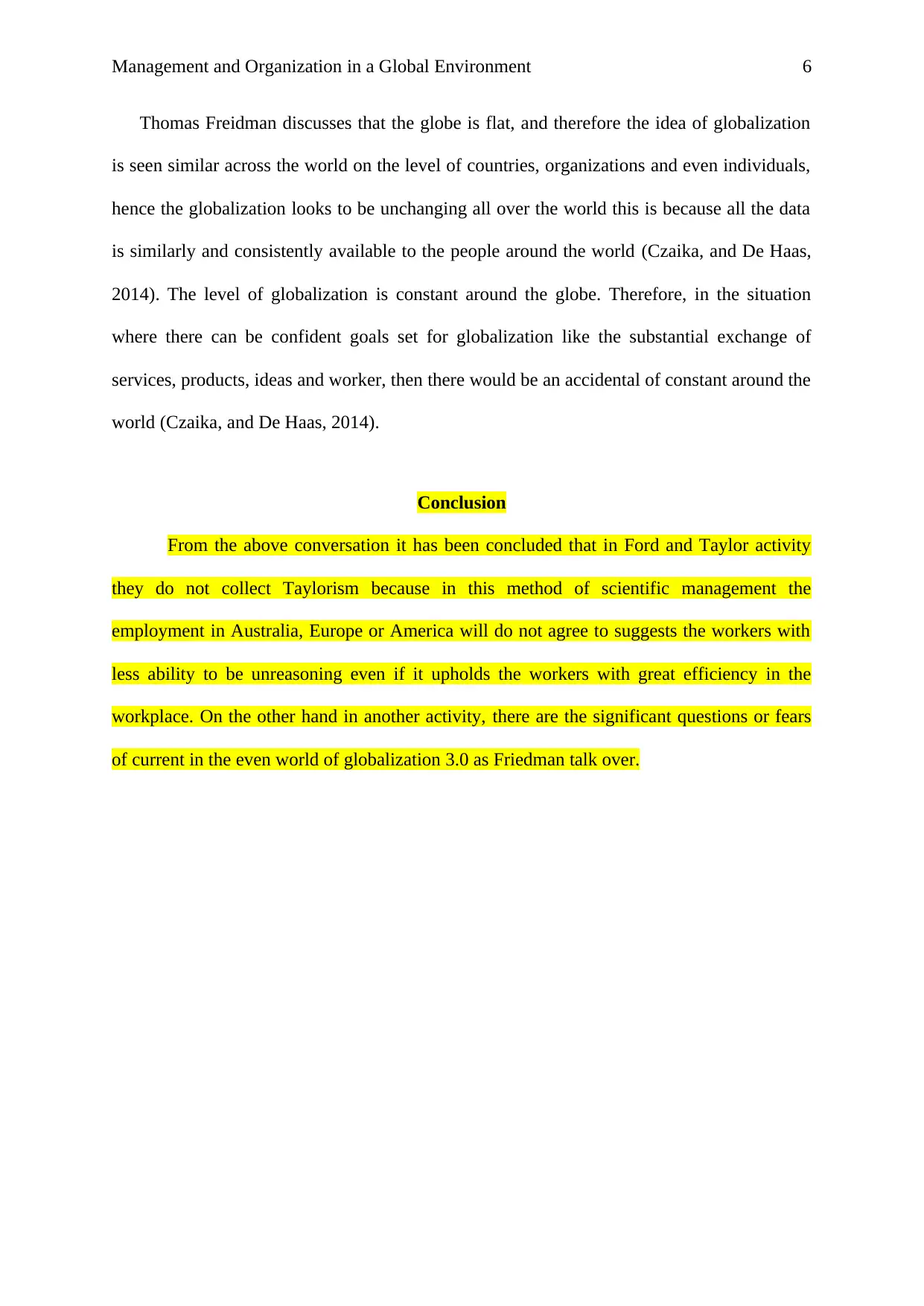
Management and Organization in a Global Environment 6
Thomas Freidman discusses that the globe is flat, and therefore the idea of globalization
is seen similar across the world on the level of countries, organizations and even individuals,
hence the globalization looks to be unchanging all over the world this is because all the data
is similarly and consistently available to the people around the world (Czaika, and De Haas,
2014). The level of globalization is constant around the globe. Therefore, in the situation
where there can be confident goals set for globalization like the substantial exchange of
services, products, ideas and worker, then there would be an accidental of constant around the
world (Czaika, and De Haas, 2014).
Conclusion
From the above conversation it has been concluded that in Ford and Taylor activity
they do not collect Taylorism because in this method of scientific management the
employment in Australia, Europe or America will do not agree to suggests the workers with
less ability to be unreasoning even if it upholds the workers with great efficiency in the
workplace. On the other hand in another activity, there are the significant questions or fears
of current in the even world of globalization 3.0 as Friedman talk over.
Thomas Freidman discusses that the globe is flat, and therefore the idea of globalization
is seen similar across the world on the level of countries, organizations and even individuals,
hence the globalization looks to be unchanging all over the world this is because all the data
is similarly and consistently available to the people around the world (Czaika, and De Haas,
2014). The level of globalization is constant around the globe. Therefore, in the situation
where there can be confident goals set for globalization like the substantial exchange of
services, products, ideas and worker, then there would be an accidental of constant around the
world (Czaika, and De Haas, 2014).
Conclusion
From the above conversation it has been concluded that in Ford and Taylor activity
they do not collect Taylorism because in this method of scientific management the
employment in Australia, Europe or America will do not agree to suggests the workers with
less ability to be unreasoning even if it upholds the workers with great efficiency in the
workplace. On the other hand in another activity, there are the significant questions or fears
of current in the even world of globalization 3.0 as Friedman talk over.
Paraphrase This Document
Need a fresh take? Get an instant paraphrase of this document with our AI Paraphraser
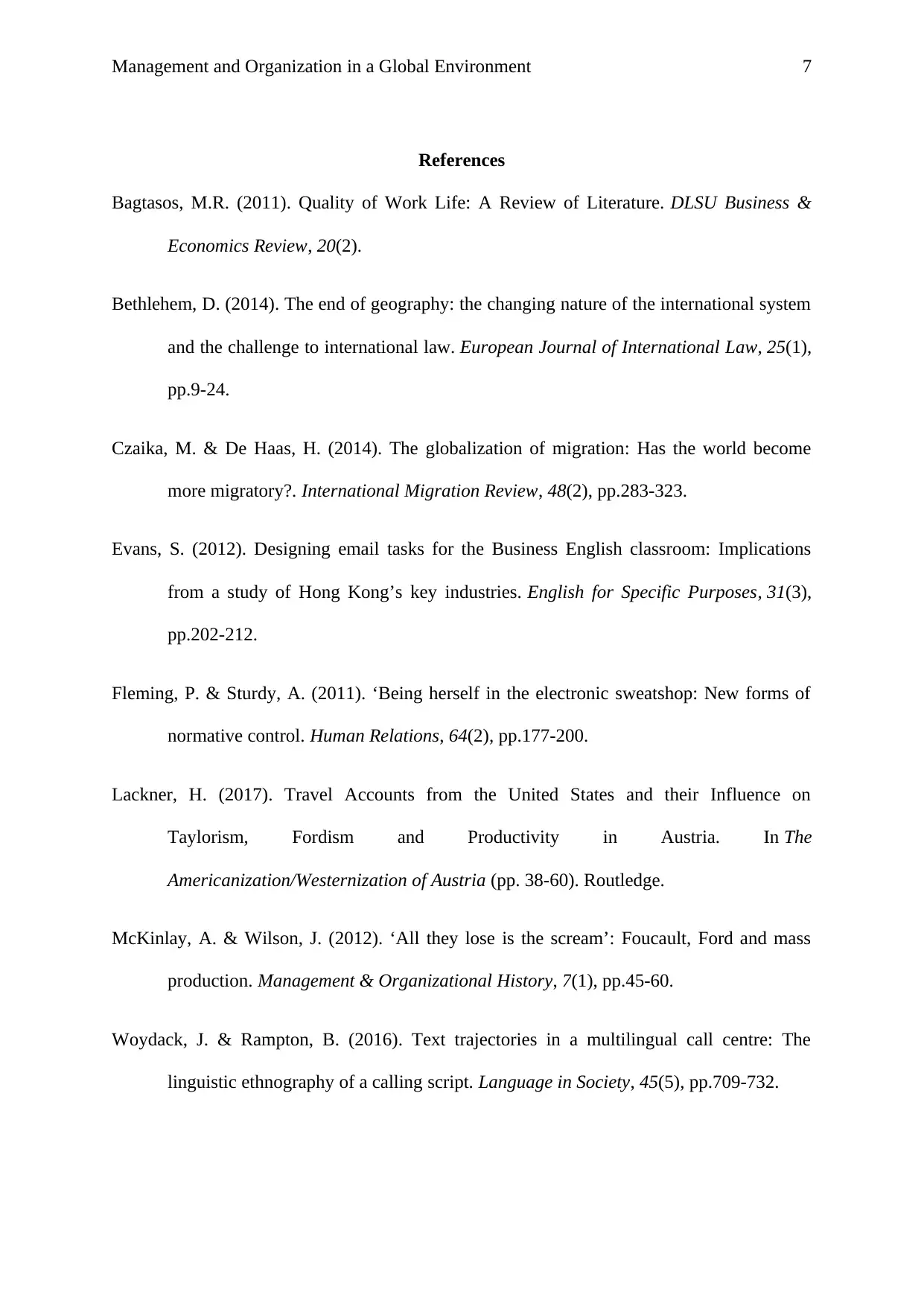
Management and Organization in a Global Environment 7
References
Bagtasos, M.R. (2011). Quality of Work Life: A Review of Literature. DLSU Business &
Economics Review, 20(2).
Bethlehem, D. (2014). The end of geography: the changing nature of the international system
and the challenge to international law. European Journal of International Law, 25(1),
pp.9-24.
Czaika, M. & De Haas, H. (2014). The globalization of migration: Has the world become
more migratory?. International Migration Review, 48(2), pp.283-323.
Evans, S. (2012). Designing email tasks for the Business English classroom: Implications
from a study of Hong Kong’s key industries. English for Specific Purposes, 31(3),
pp.202-212.
Fleming, P. & Sturdy, A. (2011). ‘Being herself in the electronic sweatshop: New forms of
normative control. Human Relations, 64(2), pp.177-200.
Lackner, H. (2017). Travel Accounts from the United States and their Influence on
Taylorism, Fordism and Productivity in Austria. In The
Americanization/Westernization of Austria (pp. 38-60). Routledge.
McKinlay, A. & Wilson, J. (2012). ‘All they lose is the scream’: Foucault, Ford and mass
production. Management & Organizational History, 7(1), pp.45-60.
Woydack, J. & Rampton, B. (2016). Text trajectories in a multilingual call centre: The
linguistic ethnography of a calling script. Language in Society, 45(5), pp.709-732.
References
Bagtasos, M.R. (2011). Quality of Work Life: A Review of Literature. DLSU Business &
Economics Review, 20(2).
Bethlehem, D. (2014). The end of geography: the changing nature of the international system
and the challenge to international law. European Journal of International Law, 25(1),
pp.9-24.
Czaika, M. & De Haas, H. (2014). The globalization of migration: Has the world become
more migratory?. International Migration Review, 48(2), pp.283-323.
Evans, S. (2012). Designing email tasks for the Business English classroom: Implications
from a study of Hong Kong’s key industries. English for Specific Purposes, 31(3),
pp.202-212.
Fleming, P. & Sturdy, A. (2011). ‘Being herself in the electronic sweatshop: New forms of
normative control. Human Relations, 64(2), pp.177-200.
Lackner, H. (2017). Travel Accounts from the United States and their Influence on
Taylorism, Fordism and Productivity in Austria. In The
Americanization/Westernization of Austria (pp. 38-60). Routledge.
McKinlay, A. & Wilson, J. (2012). ‘All they lose is the scream’: Foucault, Ford and mass
production. Management & Organizational History, 7(1), pp.45-60.
Woydack, J. & Rampton, B. (2016). Text trajectories in a multilingual call centre: The
linguistic ethnography of a calling script. Language in Society, 45(5), pp.709-732.
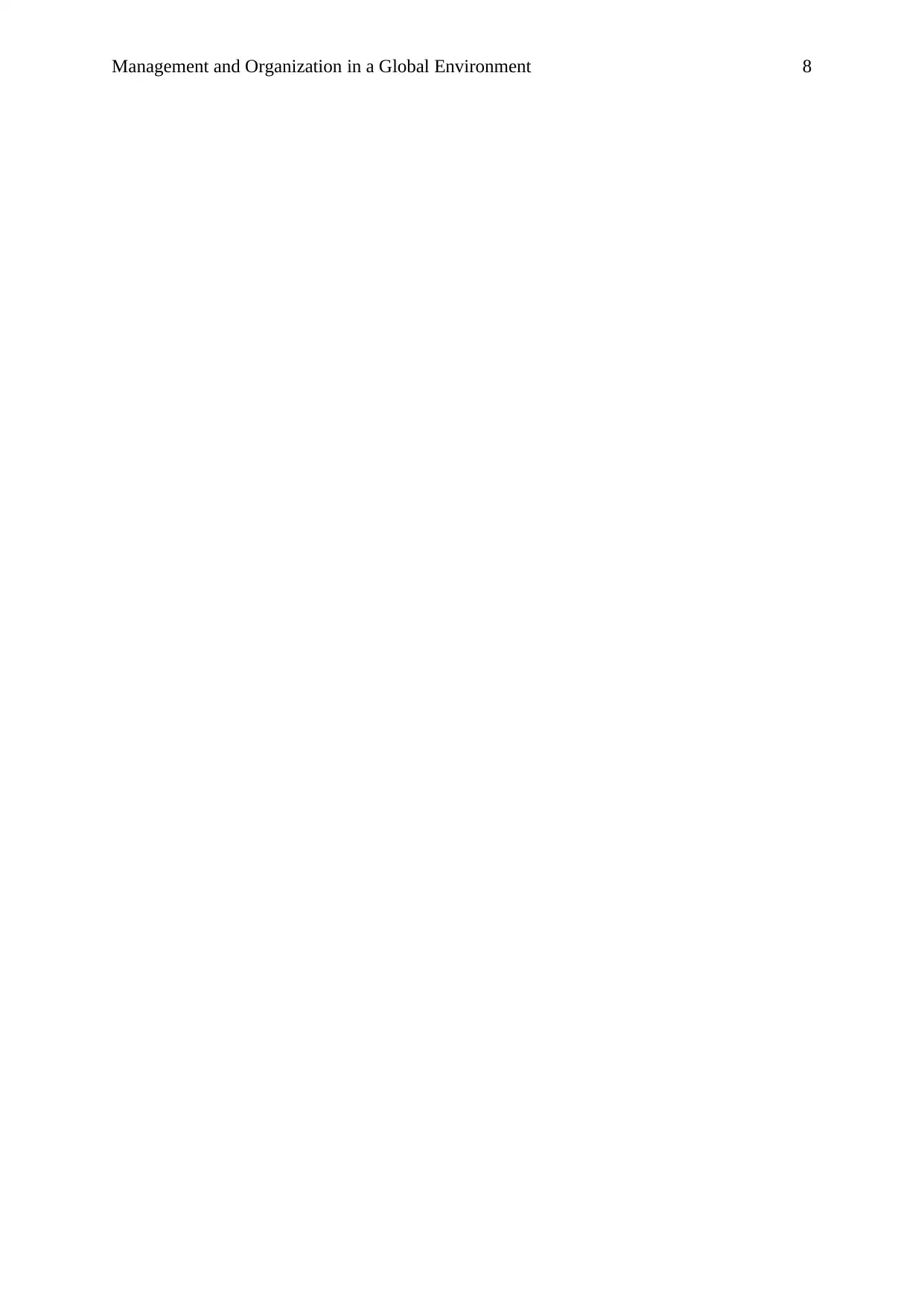
Management and Organization in a Global Environment 8
⊘ This is a preview!⊘
Do you want full access?
Subscribe today to unlock all pages.

Trusted by 1+ million students worldwide
1 out of 9
Related Documents
Your All-in-One AI-Powered Toolkit for Academic Success.
+13062052269
info@desklib.com
Available 24*7 on WhatsApp / Email
![[object Object]](/_next/static/media/star-bottom.7253800d.svg)
Unlock your academic potential
Copyright © 2020–2025 A2Z Services. All Rights Reserved. Developed and managed by ZUCOL.


